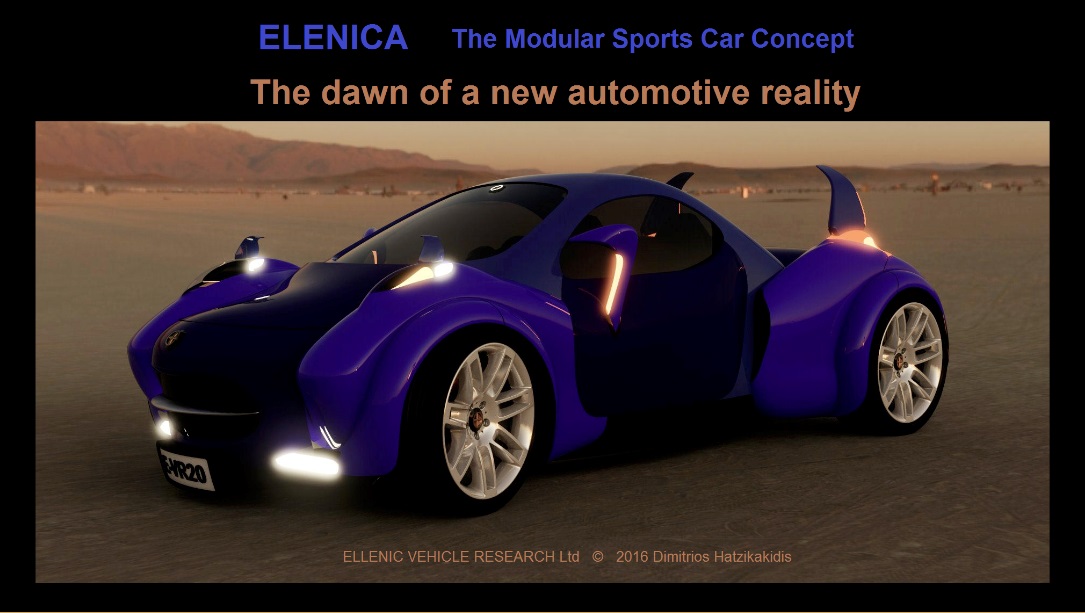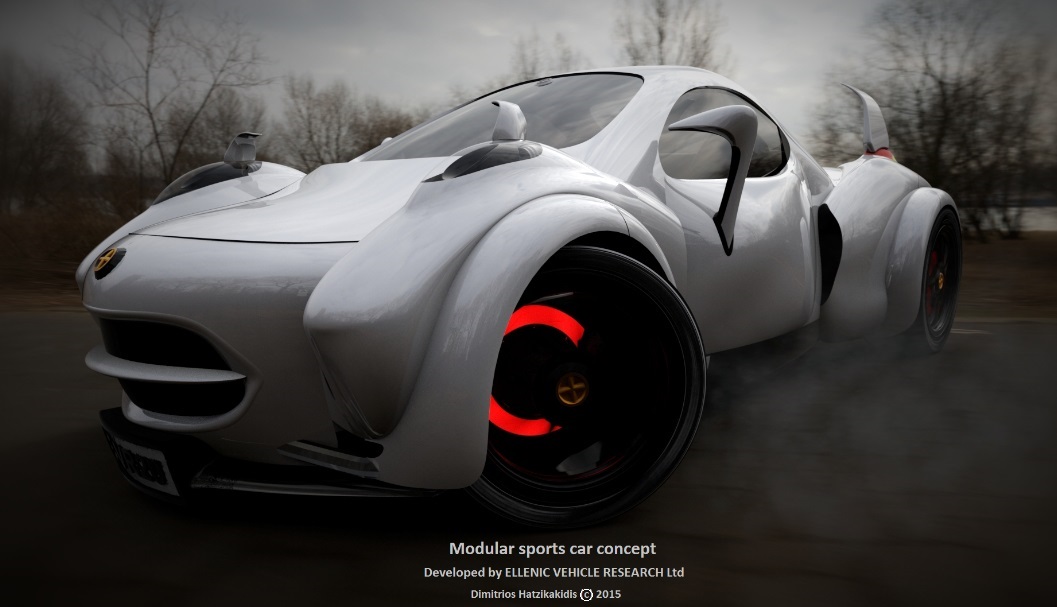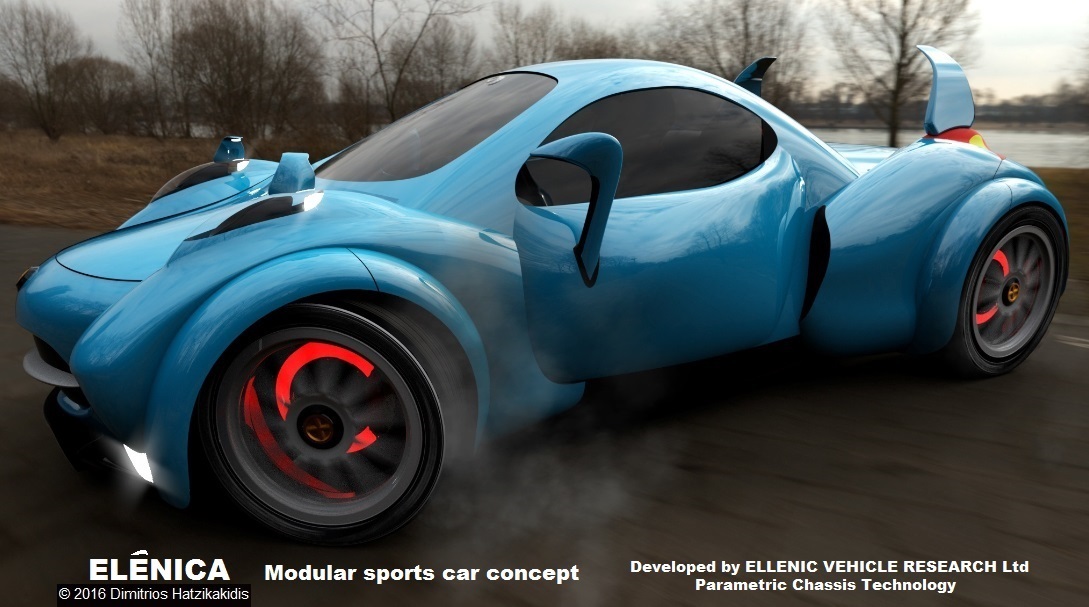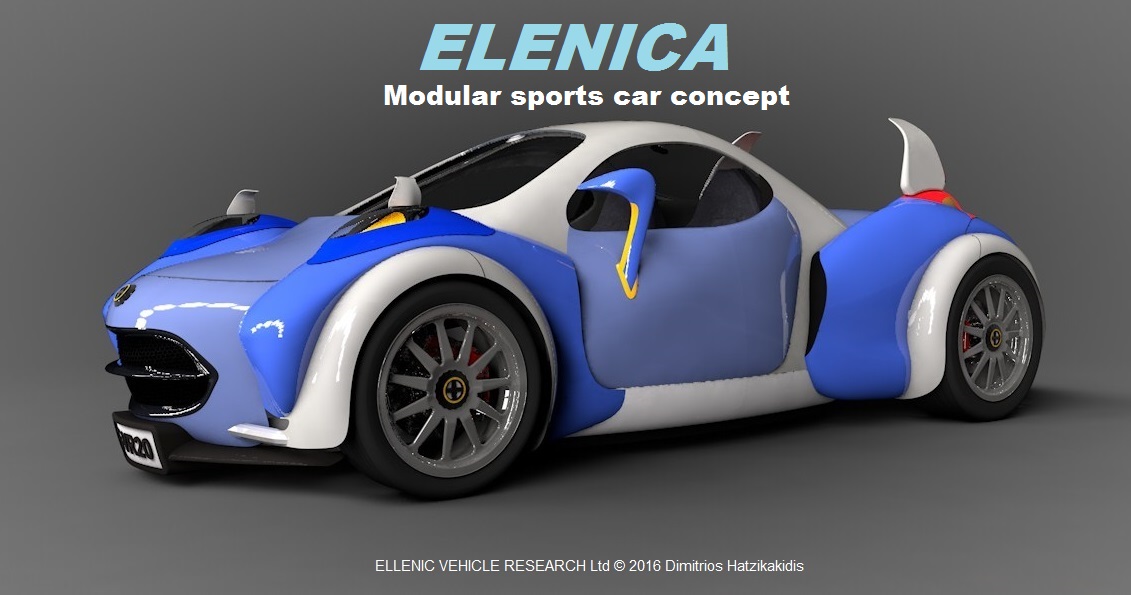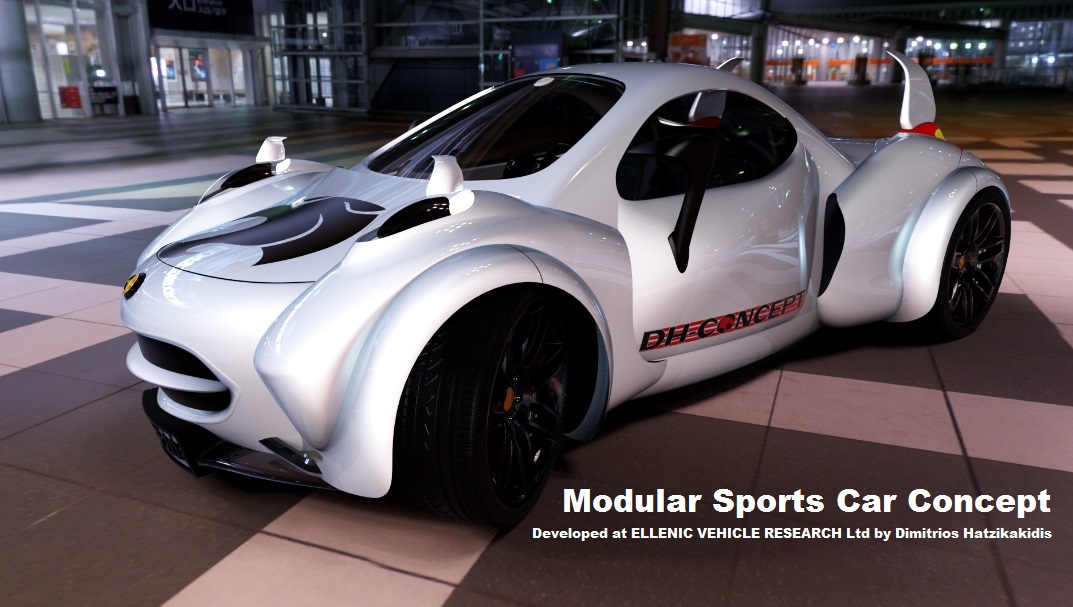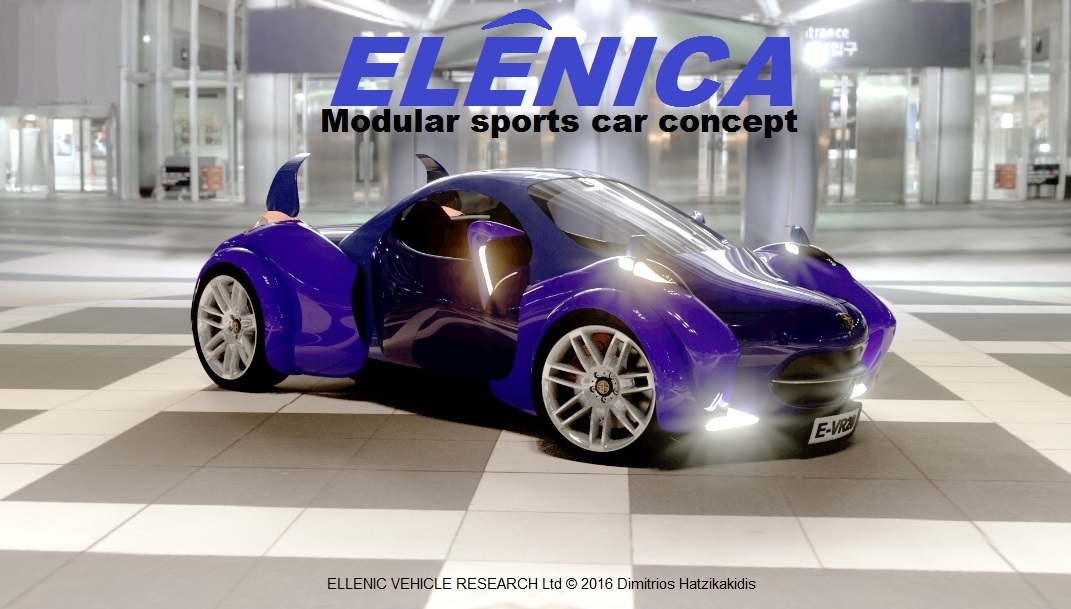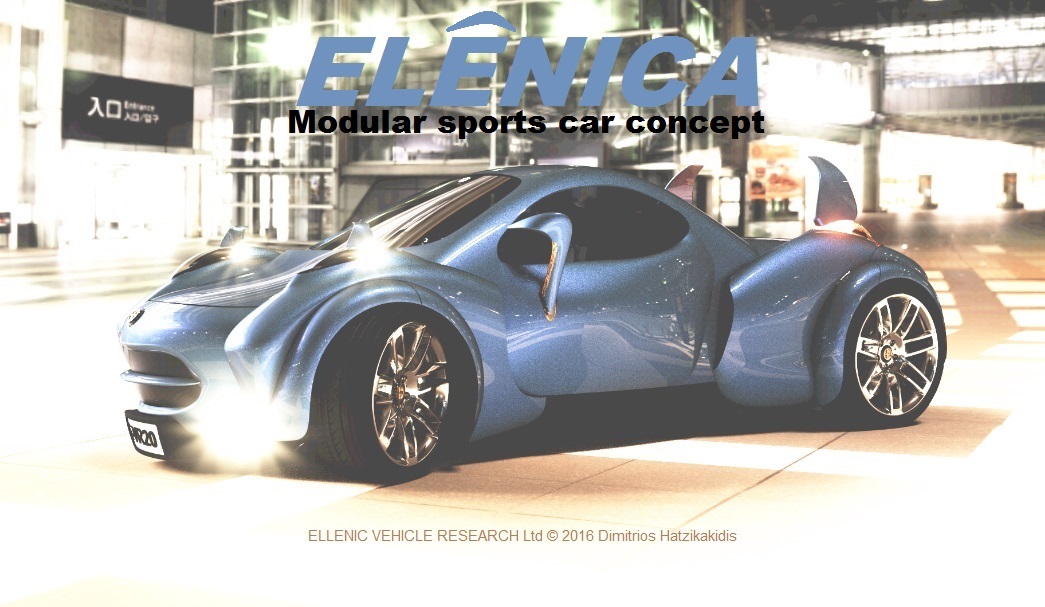ELENICA : The First supercar featuring a Parametric Chassis.
Newspaper Article (Translated) : 2016, February 16 :
Parametric Chassis and Suspension
Module Technology : The vision of Dr. Dimitrios Hatzikakidis and his
associates, who aspire to change things in the auto industry, takes shape through
the first high-end application, which has been introduced as the “Modular
sports car concept”.
This first application of their
innovative design model for cars, applicable to various categories, presented
by Hatzikakidis and his team, has had repercussions in Europe, America and
Asia.
The high-end sports car application
: “Elenica”, is the “flagship” of the on-going projects, puts on the map all
the advantages of the technology and the resulting new design methods. This
opens the way for the ground-breaking, game-changing changes in the manufacture
of electric/hybrid vehicles, conventional low-cost cars, high performance
sports cars (expensive prototypes) and military vehicles, all utilizing the
“parametric chassis recipe”.
"Elenica" is now being developed in
Switzerland and in England and it will be ready for presentation in a few
months. It is equipped with a series of original features that appear for the
first time in the world car industry and are based on the parametric chassis/suspension
module and other innovative technologies” says Hatzikakidis. Elenica
incorporates patented aerodynamic technology, the new flashing/trafficator
light cluster on the rear-view mirror, (an evolution of the original, designed
by Hatzikakidis, 30 years ago at Mercedes) and other innovative design
solutions. “Our plan is based on a technological and financial analysis that
fully covers the spectrum of design/development/manufacturing for
electric/hybrid, conventional, sports and military vehicles” he adds.
R&D Jobs
Apart from the (apparent)
technological advantages, the new design method addresses many of the
challenges the world car industry is faced with and can cope in the years to
come, as it creates a new market, (that of the “suspension module and the
parametric chassis”). This contribution could play a pivotal role in research
and development (R&D), creating jobs for engineers and scientists, as the
technology may “unlock” thousands of posts in a Europe faced with depression
and high unemployment.
The parametric chassis technology
promises wealth creation for countries involved in the process of car
design/development/manufacturing, slashing the manufacturing cost and helping
companies overcome a series of red tape and technical-financial impediments. It
is no coincidence that the major car industry players (multinationals, OEMs,
design-houses, international research and industrial applications agencies) are
following every step of Hatzikakidis and his team, who have managed recently to
secure new patents and develop new prototypes, despite the … trip ups attempted
by certain OEMs (attempting to copy patents and design solutions), in order to
reap some benefits from the development of this new technology.
Influential figures in the industry
admit however, that attempts of this kind are “at-the-end-of-the-day
counter-productive”, since one of the major advantages of the “parametric chassis
and the suspension module technology” is that it has the ability to evolve
continually into many directions, creating new technological sectors and
markets. It seems unavoidable, therefore, that the big companies will
eventually cooperate with the Hatzikakidis team, to the benefit of the global
car market, which swirls in the spin of economic crisis and stagnating
technology.
"We can keep creating new
applications and dozens of new patent-trees on the technology we have created.
It would, therefore, be to the OEMs’ advantage to cooperate with us, instead of
striving to benefit from our technology, without us. Further, we have in our
hands a technology that allows us to simplify the production process by keeping
certain sections of high precision and low tolerance, manufactured in Europe
and completing final assembly overseas, where the manufacturing cost is lower.
For instance, the suspension module could be made in Europe and be sent for
final assembly to Asia or Africa. Keeping the industrial production in Europe
is something the European politicians and industrialists were unable to
implement in the recent decades, as part manufacturing in Asian countries was
the only choice, given that all existing traditional technologies have “reached
total depreciation” and the only criterion is “a low industrial cost”. With new
technologies, of the type we are creating, the end benefits of 1 less weight, 2
better performance and 3 cost-effective upgradeability potential are
accomplished “by design”, thanks to the new, innovative, original design of the
product and the procedures developed” explains Dr Hatzikakidis.
Suspension modules and chassis give
a car game-changing advantages.
The parametric chassis and the
suspension module technology, that focuses on the original design and frees the
external styling, is based on an initial simple array of suspension and chassis
that offers a vehicle flexibility, comfort and quality characteristics of much
more expensive cars. Instead of the four conventional suspensions in use today,
we fit four times, at the chassis corners, the same (fully adjustable)
suspension module, thus, creating the parametric chassis. In the case of
electric/hybrid vehicles the suspension module is also equipped with an
electric motor, while the usually heavy and bulky batteries are accommodated at
centre of the chassis. In this way we make an original chassis that endows the
car with improved structural rigidity, crash characteristics and reduces its
overall weight impressively.
“The chassis may be built much
lighter, with optimal separation of subsystems (e.g. control collapse zones).
The parametric chassis technology introduces us also to the innovation of the “complementary self carrying body”, as it has been
patented by us, in Japan in 2015, which allows the building of a car 250 kg
lighter” explains Dimitrios Hatzikakidis.
Seven road-going prototypes are now
being developed and tested :
The suspension module is adjustable
with upgradeability options into three levels : “Functions at the visco-elastic
level, is upgraded to an electromechanical system and reaches an
electromagnetic suspension/harvesting array, at (comparatively) lower cost. The
upgrading extends also to the active / adaptive level. We have categorized more
than 50 parameters for design, evolution and industrialization, that have been
thoroughly studied in the recent years” Hatzikakidis points out.
His team, with associates in
various countries, can fully cover mechanical and technological issues, to
handle matters of copyright and business strategy and satisfy the trends of
contemporary marketing. “We have worked out extensive business plans at four
levels of application: a) intellectual property, b) limited industrial
application, with manufacture of sections of our suspension modules, c)
industrial application of the entire parametric chassis, d) manufacture of a
complete car with our technologies. There is a wide field of implementation
from conventional vehicles to electric, electric/hybrid and military vehicles.
In total seven vehicles are now at the stage of testing, among them two “Modular
Sports Car Concept” vehicles, that will lead us to the (super)car
Elenica”.
The Parametric Chassis and Suspension Module innovation
(Translated Newspaper Article : 2013, May 11)
Emphasis on innovation, can be used for the design of vehicles across the board, reduces the time and cost in Design / Development, manufacturing / assembly of
new models and is ready for future technologies.
The Suspension Module and the technology of the “Parametric Chassis”, created by
the mechanical-engineer, Dr Dimitrios Hatzikakidis, and his team, may change
things in car Design and Manufacturing. The starting point is an (initially) simple and
effective assembly, (the suspension module), that is used to make up a light and
robust chassis. It involves a number of worldwide patents, dozens of filings with the
international patent offices, in all the major markets.
"The most important aspect of the invention is the design of the “chassis and the
suspension as one unit”. The use of a “standardized suspension module”, placed at
the four corners of the frame, in addition to “wheelbase elements”, which are cut to
size in order to "build" the floor of the vehicle, decreases cost. “Vehicle
manufacturers usually avoid change, due to fear. But in this case there is no risk, the
financial payback is immediate ", says Professor Konstantinos Spentzas, founder of
the Road Vehicle Laboratory, School of Mechanical Engineering of NTUA, who
follows the evolution of this technology for over 15 years.
“The new design method based on the technology of the “Suspension Module and
the Parametric Chassis”, gives a vehicle more stability and offers features of a much
more expensive car. The use of a rotational-damper, instead of a linear
(reciprocating) damper, is another major innovation. The rotary application is more
energy efficient, and now allows the adoption of very expensive technologies, at a
lower cost. This new module can also be used in designing any traditional
conventional) suspension, (such as double wishbone or multi-link), giving us the
opportunity to reach out into new automotive applications, and various vehicle
production processes”, says Prof. Spentzas.
“Save energy and money by the application of a common (and fully adjustable)
Suspension Module is a double mission." Dr Hatzikakidis explains, "each suspension
module functions as both a “spring” and a “damper”. It is something that happens for
the first time ; as until now, the two elements were separate and connected in
parallel. For the last 90 years, this was done due to the respective historical origins,
of the two separate components (spring, damper). In our new suspension module
(and chassis), the energy accumulation /dissipation occurs at the same time, and in
the same place ".
The “Suspension Module and the Parametric Chassis technology” over the last 15
years, has prompted Dr Hatzikakidis and his colleagues to develop many novel
“implementation and innovation” strategies. This technology can be applied in
conventional, commercial, hybrid / electric vehicles, but also has a very important
military application, in vehicles and tanks. Moreover, it creates an entirely new
market in a “suspension module product”, that up until now, were just ‘spare parts’.
"The idea of the suspension module allows us to change both the
design/development process of vehicles, as well as, the manufacturing/assembly
processes. This prompted us to adopt completely innovative processes in strategies
and tactics in Product Design, Research & Development, Intellectual Property in all
the major markets worldwide. In the last few years, we had to apply innovative tactics
in Research (R & D, Industrialization) for our experimental technology, while
developing technology demonstrators and pre-industrial prototypes simultaneously in
many markets. Also, we are creating an entirely new market for suspension modules.
Our other big goal is connecting to Overall Vehicle Design and Styling, many of our
key technological advantages and innovations. One such example is the application
of our “Controlled Discontinuity” Design process, Hatzikakidis notes.
The technology of the suspension modules primarily focuses on chassis and car body design, which serves as the “basis” for creating the styling of a car. At a time
when traditional design - style companies fail because of the financial crisis, Dimitrios
Hatzikakidis presents a completely different model for vehicle design, bringing
innovation to the fore and provide a new proposal to produce products on a global
scale.
Can adapt to future applications
The biggest advantage of this model is its ability to "keep up" with technological
developments. "The Parametric Chassis “opens the door” to a new generation of
technologies and can be adapted to future applications in the coming years. Making
currently very expensive technologies (such as active / adaptive, variable springing /
damping) much cheaper. “Exotic” future applications can be made cost-effective
within our existing framework", says Dr. Hatzikakidis. It is worth noting that the new
innovative method in vehicle design/assembly has already attracted the interest of
two multi-nationals, several design firms, major OEMs and institutions in China and
Hong Kong.
